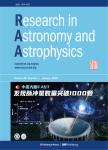版权所有:内蒙古大学图书馆 技术提供:维普资讯• 智图
内蒙古自治区呼和浩特市赛罕区大学西街235号 邮编: 010021

作者机构:National Astronomical Observatories/Yunnan Observatory Chinese Academy of Sciences Key Laboratory for the Structure and Evolution of Celestial Objects Chinese Academy of Sciences University of Chinese Academy of Sciences College of Science/Department of Physics & NAOC-GZU-Sponsored Center for Astronomy Research Guizhou University
出 版 物:《Research in Astronomy and Astrophysics》 (天文和天体物理学研究(英文版))
年 卷 期:2013年第13卷第9期
页 面:1052-1062页
核心收录:
学科分类:07[理学] 070401[理学-天体物理] 0704[理学-天文学]
基 金:supported by the National Natural Science Foundation of China (Grants Nos. 10373023 10773027 and 11263001)
主 题:stars:binaries: close stars:binaries: eclipsing stars: spots
摘 要:We carried out time-series photometric observations in the Re-band of the young, poorly studied open cluster ASCC 5 during November and December, 2012, to search for magnetically active stars, and discovered four eclipsing binary stars in this field. In order to characterize these four newly discovered binaries, we derived their orbital periods by their times of light minimum, estimated their effective tem- peratures based on their (J - H) colors and analyzed their light curves using the Wilson-Devinney light curve modeling technique. Our analyses reveal that all of them are contact binaries with short orbital periods of less than 0.5 d, with spectral types from late-F to mid-K. Among them, one is a typical A subtype contact binary with a mass ratio around 0.5 and a period of 0.44 d, and one is an H subtype contact binary with a high mass ratio around 0.9 and a short period of about 0.27 d. The other two systems show low amplitudes of light variation (Ant 〈0.11m); their actual photomet- ric mass ratios could not be determined by the light curve modelings, probably due to their attributes of being partially eclipsing stars. A preliminary analysis for these two systems indicates that both of them are likely to be W subtype contact binaries with low orbital inclinations. In addition, both of these two low amplitude variables show asymmetric distorted light curves (e.g., O'Connell effect of ARc --~0.02m) during the observing runs, suggesting the presence of starspots on these two systems. More inter- estingly, the one showing a large case of the O'Connell effect presented a remarkable variation in the shape of the light curve on a time scale of one day, indicating that this star is in a very active state. Therefore, these two stars need spectroscopic observations to precisely determine their parameters, as well as further photometric observations to understand the properties of their magnetic activity, e.g., the evolution of starspots.